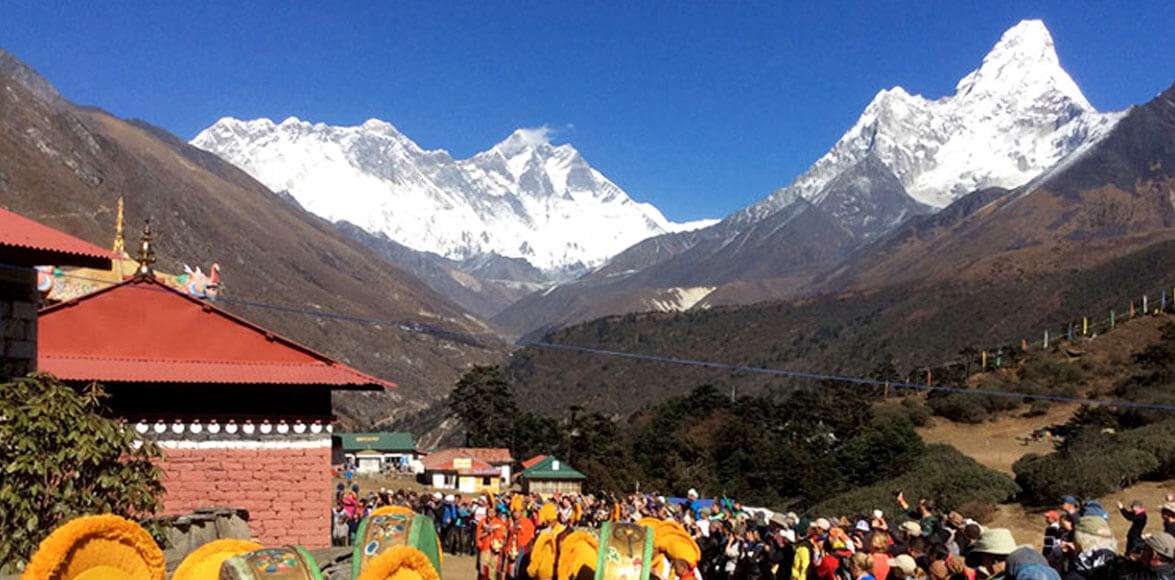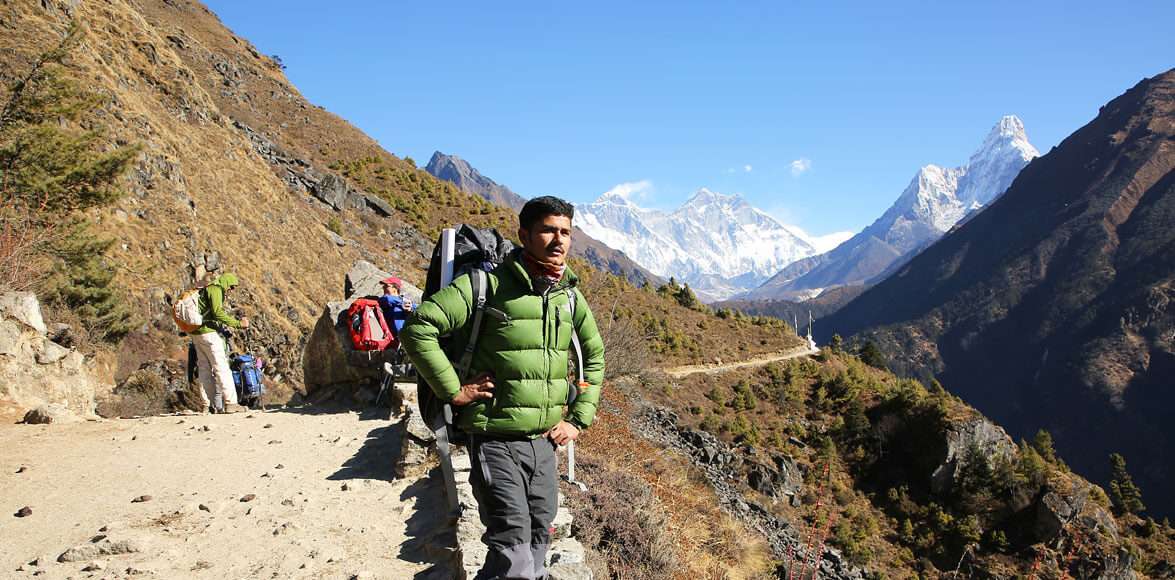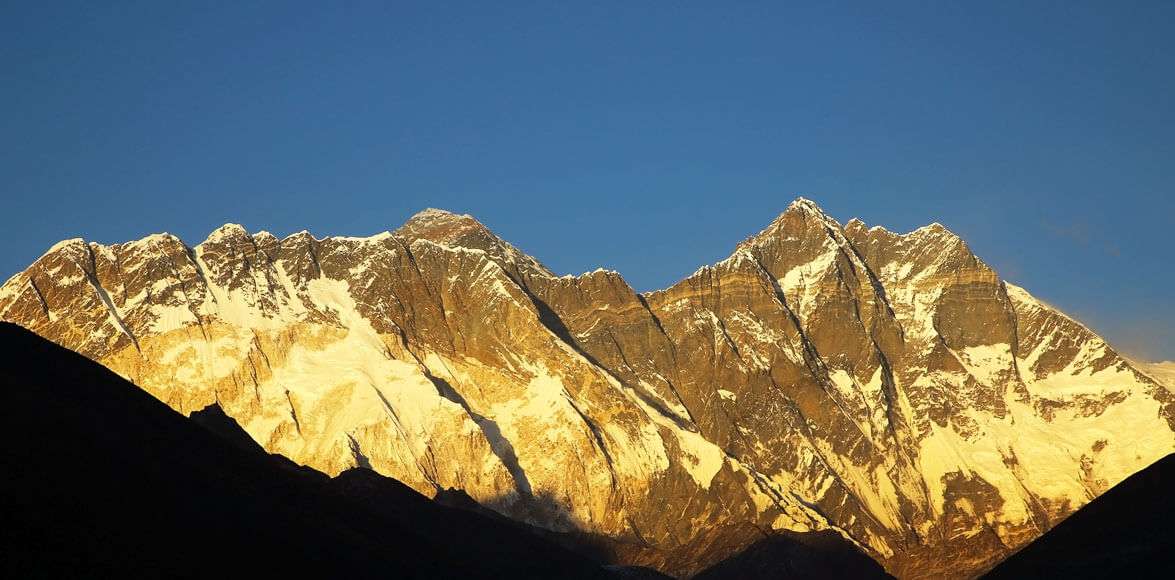Trip Overview
The Mani Rimdu Festival is a 19-day long festival celebrated in the Khumbu region. Among those 19 days, three days are open for public celebration. Mani Rimdu is the biggest and most significant festival for the locals of the region. The main three days of the festival are celebrated at the oldest monastery of the Region, the Tengboche monastery.
The Mani Rimdu festival is celebrated by performing an ancient mask dance. The monks exhibit the dance that portrays the victory of Buddhism over the primal Bor religion. The dance also depicts surmounting the demons by Guru Rinpoche. Hundreds of Sherpas from all around the region gather at the monastery to attend the celebration and pay their respect. The festival occurs every year during the annual full moon.
We at Escape Nepal have designed 14 Days itinerary for the Mani Rimdu Festival Trek. The itinerary includes your arrival and departure days to and from Nepal, A day tour in Kathmandu, and an extra day at the end of the trek to use on the trek, or flight to Lukla if in case, the Lukla flight is delayed or canceled due to bad weather, which may happen sometimes. If you have more days and want to reach Everset Base Camp, you can also combine the festival celebration with Everest Base Camp Trek.
Know little more about the Mani Rimdu Festival in Tengboche Mosantery
Construction of the Sand Mandala
Sand Mandala is built using colorful sand, which represents Garwang Thoze Chenpo (Lord of dance). The mandala shows complicated and symbolic design.
It takes many days to complete the Sand Mandala. After the construction of the mandala, it gets decorated with different elements all of which are ritual values.
A defensive blade is placed around the mandala that symbolizes deities and a bowl of Mani Rilwu (spiritual medicine) is placed in the center of the mandala.
The monks repeat a mantra called "OM AH HUNG RHI, OM MANI PADME HUNG” thousands of times perceiving kindness flowing in the form of mantra into the mandala and the medicines. Later, this kindness is released out from the mandala blessing all the attendees of the festival.
Wong (The Empowerment)
Wong is the first day of the public ceremony. This happens on the full moon day, usually on the tenth month in the Tibetan lunar calendar. During the Wong, the sacred Mani Rilwu (spiritual pills) and Tshereel (pills for long life) are distributed to everyone attending the festival.
Chham (The Dances)
Chham Dance happens on the 2nd day of the Mani Rimdu festival. The dance symbolizes conquering over demons, chasing them away, and getting transformed into protectors of Dharma.
Similarly, the dance conveys different levels of Buddhist teaching from the simplest to the most philosophical. The locals believe that the performers, the monks become diving during the dance.
Ser-Kyem
Ser-Kyem is used to offer alcohol from silver vessels and small tormas to the Lama, Yidam, Khandro, and Shi-Dak (the Earth deities). As per Tibetan Buddhist practice, this offering helps these Earth deities with the virtuous actions which lead to Buddhahood. Likewise, Ser-Kyem is also used to offer spiritual nectar made in many ceremonies.
The Fire Puja (Jinsak)
The Fire Puja or Jinsak is performed in the yard the day after the dances. This puja is an offering to the fire god and to the gods of the Sand Mandala to relieve all harm in the world. The harm is visualized as dissolving into the grain and butter is burned. After this, the Sand Mandala in the temple is cut into pieces, and the sand is given as an offering to the serpent gods (Nagas).
Chhingpa
Chhingpa is another dance that portrays the Four Protecting Ghings, defending the Buddhist faith against attack by demons. The performers were shining paper masks to hide their faces each illustrating a constant smile.
The dancers´ hops are rhythmically accompanied by the beating of cymbals. To make the celebration fun, the dancers scare the children in the audience.
Likewise, the Dakini dance is performed genially. Slow dance moves, keeping perfect time along with the soft tinkle and slow beat of the bells & drums.
Five young priests perform this dance without masks and portray female spiritual figures, the partners of Padmasambhava. Later, they announce the arrival of Guru Rinpoche at the Manu Rimdu. Two of the Ghing are male, and carry cymbals, while the two females carry drums. The males represent skillful means and the female represents wisdom.
Things to See & Experience on Mani Rimdu Festival Trek
Fly from Kathmandu to Lukla
A thrilling and short 35 minutes flight from Kathmandu takes you to Lukla. This is one of the most adventurous flights you take in your life. During the flight, you get to see a birds-eye view of the Himalayas along with the wonderful landscape.
Get to see diverse flora and fauna while passing through Sagarmatha National Park
To reach Namche Bazar, you trek through Sagarmatha National Park, which is home to hundreds of unique flora and wildlife.
The national park includes many dense forests, small villages, and streams. Monjo is the starting point of the park, and the trail steeply ascends to Namche Bazar.
Explore Namche Bazar
The biggest Sherpa settlement, Namche Bazar is the tourist hub of the Khumbu region. Here, you get many modern facilities from diverse food options to the ATM and WiFi.
You can visit the library, cafes, Sherpa Culture Museum, and Everest Photo Gallery in the village. There are also options for a short hike to witness gorgeous views of the Himalayas from Everest View Hotel or Syangboche Airstrip.
Get to see the lifestyle and culture of Sherpa
Sherpa is known as the superhuman who are not only surviving in the extreme environment of the Himalayas but also have skills that cannot be found in any other person globally.
During your overnight stay in different villages, you get to see the daily lifestyle of these people. Likewise, this very journey is designed to let you experience the culture and tradition of Sherpa.
Visit Tengboche monastery
Tengboche monastery is located in the Tengboche village. It is a very important monastery for the locals. This is the oldest and the biggest monastery in the Khumbu region.
From the back of the monastery, you can see stunning views of the Himalayas. This is the place where you are celebrating the Mani Rimdu Festival for the next few days.
Celebrate Mani Rimdu Festival with locals
Mani Rimdu festival is a significant celebration that is celebrated by Sherpas every year. The locals and the lamas gather at the Tengboche monastery and pray for three days to celebrate the festival.
Mani Rimdu festival is celebrated for the welfare of the world. The dances performed represent the Buddhist destruction of all the pagan gods that live in the Himalayas. The monks get dressed up in masks to represent the old ghosts that were exorcised.
Witness stunning scenery and tempting views of the Himalayan Mountains
Mani Rimdu Festival Trek allows you to explore the sensational beauty of the Khumbu region. The trail offers beautiful landscapes along with amazing views of snow-capped mountains.
You get to see views of Mt. Everest (8,848 m), Mt. Lhotse, Mt. Nuptse, Mt. Ama Dablam, Mt. Thamserku, Mt. Kongde, and many other Himalayan mountains.



